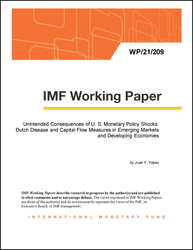
Unintended Consequences of U. S. Monetary Policy Shocks: Dutch Disease and Capital Flow Measures in Emerging Markets and Developing Economies
Unintended Consequences of U. S. Monetary Policy Shocks: Dutch Disease and Capital Flow Measures in Emerging Markets and Developing Economies
READ MORE...
Volume/Issue:
Volume 2021
Issue 209
Publication date: August 2021
ISBN: 9781513589749
$5.00
Add to Cart by clicking price of the language and format you'd like to purchase
Available Languages and Formats
| English |
Prices in red indicate formats that are not yet available but are forthcoming.
Topics covered in this book
This title contains information about the following subjects.
Click on a subject if you would like to see other titles with the same subjects.
Exports and Imports , Economics- Macroeconomics , Economics / General , monetary policy shock , LBD externality , Dutch disease effect , emerging markets and developing economies , EMDEs monetary policy framework , Dutch disease , Capital inflows , Exchange rates , Exchange rate arrangements , Global
Summary
Dutch disease is often referred as a situation in which large and sustained foreign currency inflows lead to a contraction of the tradable sector by giving rise to a real appreciation of the home currency. This paper documents that this syndrome has been witnessed by many emerging markets and developing economies (EMDEs) as a result of surges in capital inflows driven by accommodative U. S. monetary policy. In a sample of 25 EMDEs from 2000-17, U. S. monetary policy shocks coincided with episodes of currency appreciation and a contraction in tradable output in these economies. The paper also shows empirically that the use of capital flow measures (CFMs) has been a common policy response in several EMDEs to U.S. monetary policy shocks. Against this background, the paper presents a two sector small open economy augmented with a learning-by-doing (LBD) mechanism in the tradable sector to rationalize these empirical findings. A welfare analysis provides a rationale for the use of CFMs as a second-best policy when agents do not internalize the LBD externality of costly resource misallocation as a result of greater capital inflows. However, the adequate calibration of CFMs and the quantification of the LBD externality represent important implementation challenges.
Copyright © 2010 - 2025
Powered by:
AIDC



